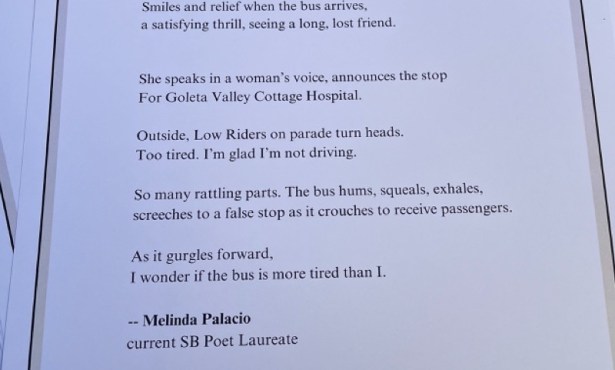Arnoldi’s Chef Is Cracking Pi
S.B.’s Tim Hushion Asserts Randomness May Be Predictable with Pi
Every math student learns at some point that the number pi (3.14…) can be used to determine the proportions of a circle. But what if it could be used to predict gambling outcomes, grasshopper populations, and terrorist attacks?
According to decades of research by Tim Hushion, it can. Through a series of dice-rolling trials and using principles from quantum mechanics, Hushion, who also works in the kitchen at Arnoldi’s, argues that events perceived as random can in fact be predicted as a tendency of geometric probability in relation to a fraction of pi. “Relative to the randomness of gravity, we and our perceptions are pi,” he asserts. With National Pi Day coming ’round on March 14, there couldn’t be a more timely opportunity to taste a slice of his investigations into the world of pi.
For his entire life, Hushion has seen patterns in realms others saw as inscrutable. As an 8-year-old, he remembers feeling certain that randomness was a code that could be cracked. Beyond physics and statistics, the former research attorney and forensic historian has extensively studied the French Revolution, the O.K. Corral, and Chumash culture; he interprets the Chumash Painted Cave as a map of the area’s food resources rather than a spiritual or shamanic artwork.
With pi, he’s delving into theories put forth in the 1700s by Ruđer Josip Bošković, who believed that distinct particles could affect other objects from a distance. That intrigued Albert Einstein, who thought it was “spooky” that vastly separated particles could influence each other by apparently hidden forces. In 1964, John Bell’s theorem, known as Bell’s Inequality, found correlated states between the properties of distant systems, which is a cornerstone of Hushion’s work.
On his website, CrackingPi.com, Hushion compares quantum physics principles to a roulette wheel: Look at every random event as a circle through which runs a straight center of gravity, with outcomes spaced along the diameter of the object, game, or field. So a fraction of pi may help us guess an outcome based upon the implied rotation of that object.
To test his theory, I asked three volunteers to help with a series of dice rolls at the Cliff Room. Though results are still being tabulated and a retrial is in the works, Hushion feels very certain he’s onto something.
The implications could be profound: that the seemingly random universe is just a game of dice and the seemingly random future could be predictable.



